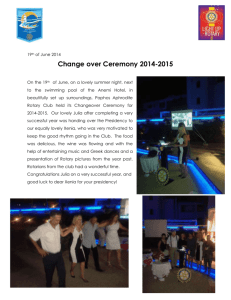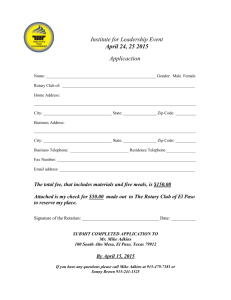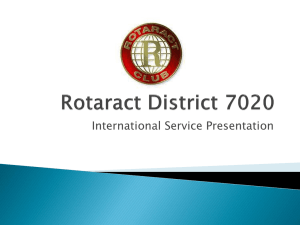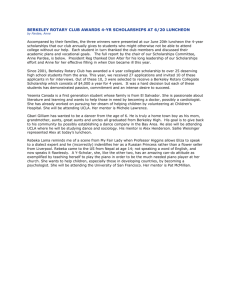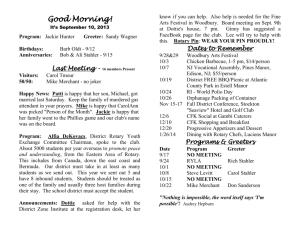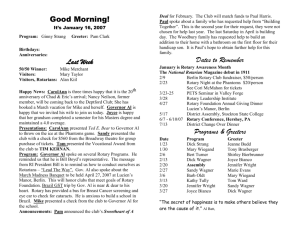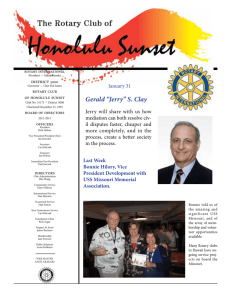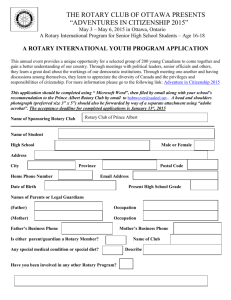International Service 101, Part 2
advertisement
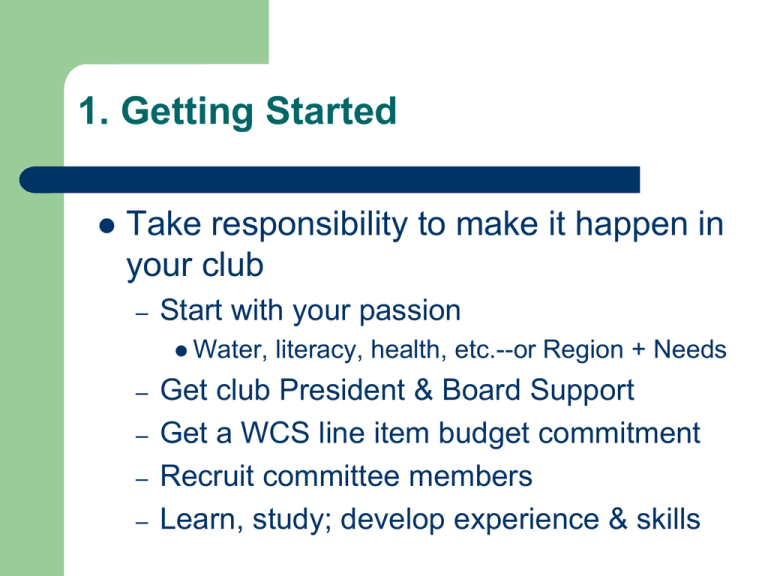
1. Getting Started Take responsibility to make it happen in your club – Start with your passion Water, – – – – literacy, health, etc.--or Region + Needs Get club President & Board Support Get a WCS line item budget commitment Recruit committee members Learn, study; develop experience & skills 2. Do Some Basic Homework Read about Humanitarian Service on www.Rotary.org and D5100WCS.org including: Guide to Matching Grants (form 141en at www.Rotary.org/RIdocuments) http://bit.ly/I7Nh7s Study the booklets, forms, spreadsheets & checklist on our District 5100 website – D5100WCS.org Imagine you lived in the village … how would you assess, prioritize & begin to meet needs? 3. Attend Our Project Exchanges/Workshops District Level: Every 3rd Wednesday at the District Office in Wilsonville – – 4:00-5:30 PM Ask to be on Pmail list RonK@theHGroup.com K.Stromvig@comcast.net (after June 30) Attend a successful club’s International Service committee meeting – List available on our website 4. Finding a Project--1 Team up with a project underway with another club in our district – – – $500 to $5,000 Come to our monthly exchanges, read pmail, notes Call clubs … collaborate Find available projects: D5100WCS.org, MatchingGrants.org, ProjectLink and Wasrag.org – Homework & due diligence is always required 4. Finding a Project--2 Use existing connections & relationships: – – – Y.E. & G.S.E. Friendship Exchange Personal travel, International Business Project Fairs – in person or electronic Partners in Service RAGM.org … Wasrag.org … other RAGs 5. What do we mean Sustainable? • Deliverable/benefit lasts indefinitely; for a lifetime – TRF Definition: Sustainability is the capacity for maintaining outcomes long‐term to serve the ongoing need of a community after grant funds have been expended. • Essential elements of sustainability: – – – – technical solution, issues social & cultural factors financial & business-like elements empowerment & community self-sufficiency • some examples … Needs Assist Sustainability Slow, Reduce: • “1 of” Projects • Donor-dependency • Supply- or Grant-driven Think, Identify & Use: • Community Solutions • Empowerment • Use alternatives with • Local materials, jobs, manufacture, skills • Vision & Path to Future • Monitor, Measure • Evaluate & Learn 6. Other Elements of Successful Project • Appeals to Hearts & Head (greatly improves human condition) • Reliable long-term partner (reputation, checklist) • Community & members volunteerism, commitment • Meets Area of Focus, Terms & Conditions • Fiscally sound, with stewardship process • Optimizes use of $$ (aka “bang for buck”) 6. Other Elements of Success (cont’d) • • • • Measurable Outcome – Evaluate it Repeatable, Growable, Generalizeable Adopt-a-village, -area, -watershed, -country Add-in features (WaSH > stoves; School > literacy, compost>crops, microlending>enterprise) – follow community lead on needs, priorities • Plan to visit, to share, to promote ... to celebrate ... and repeat. Be infectious! 7. Resources: • RI Communities In Action booklet 605a & RI Community Assessment Tools 605c • Rotary.org – Future Vision materials, training – FV Resources page http://bit.ly/Il8sgP • Vocation Training Teams (VTT) can support International & Vocational service • TRF Performance Enhancement Program – Wasrag other RAGs and Areas of Focus 8. Have Fun! It’s not only the end product of the project, and all the good it may do … Also about the process and friendships you build along the way. Collaborate - do more than you could ever do on your own! Thank You! Ron Kelemen RonK@TheHgroup.com www.D5100WCS.ORG Stew Martin StewMartin@Nehalemtel.net


